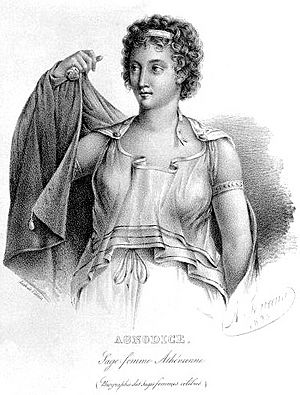Agnodice facts for kids
Quick facts for kids
Agnodice
|
|
|---|---|

Agnodice.
|
|
| Born | |
| Nationality | Greek |
| Occupation | Physician |
| Era | Classical Greece |
Agnodice (pronounced Ag-no-DEE-kay) was a famous figure from ancient Athens, Greece, who lived around the 4th century BCE. She is known as the first woman to work as a midwife or physician in Athens. Her story comes from a Roman writer named Gaius Julius Hyginus. Many people today think Agnodice might not have been a real person, but her story has been very important. It has often been used to show that women can be doctors or midwives, or sometimes, to argue against it.
According to Hyginus, Agnodice learned medicine from a famous doctor named Herophilus. She worked as a doctor in Athens, but she had to pretend to be a man. This was because women were not allowed to practice medicine back then. When she was found out, the women of Athens stood up for her. They told everyone how well she had treated them. Because of their support, Agnodice was found innocent. The law against women doctors in Athens was then changed.
Contents
Agnodice's Amazing Story
According to the writer Hyginus, women in ancient Athens were not allowed to study medicine. Agnodice really wanted to learn, so she cut her hair short and dressed like a man. She then went to Alexandria to study medicine with Herophilus.
After becoming a doctor, Agnodice returned to Athens. She wanted to help women who were having babies. Many women were too shy to see male doctors, or they simply refused. Agnodice helped them, but she was accused of breaking the law. This law said women could not practice medicine.
However, the wives of important Athenian men came to her defense. They told everyone how Agnodice had helped them. Because of their strong support, the law was changed. From then on, women were allowed to practice medicine in Athens.
Was Agnodice a Midwife or a Doctor?
Hyginus described Agnodice as an obstetrix. This word can be tricky to translate into English. Some experts think it means she was an "obstetrician". This would mean she had formal medical training, unlike regular midwives of her time.
However, other experts point out that there wasn't a formal system for doctors in the ancient world. So, it's hard to separate ancient healers into clear groups like "midwife" and "obstetrician." It's likely she was a skilled healer who helped women, whether she was called a midwife or a physician.
Is Agnodice's Story Real?
Most modern experts believe that Agnodice was not a real historical person. There are a few reasons for this doubt:
- It's unclear exactly when she would have lived.
- Hyginus claimed there were no midwives in Athens before Agnodice. But we have evidence from other writings and old carvings that midwives did exist.
Hyginus said Agnodice was taught by "a certain Herophilus." This is usually thought to be Herophilus of Chalcedon. He was a famous ancient doctor who studied women's bodies. If this is true, Agnodice would have lived in the late 300s or early 200s BCE.
Stories like Agnodice's can be found in many cultures. They often involve women showing their bodies in different ways. The meaning of her story can change depending on whether we focus on ancient medical practices or on old artworks.
Some people who believe Agnodice was real have tried to explain why there might have been no midwives before her. One idea is that there truly were no midwives. Another idea is that midwives existed but were banned by law.
Women Doctors in Ancient Greece
The story of Agnodice begins by saying "the ancients had no midwives." But at the end, it says freeborn women were allowed to learn "medicine." This makes us wonder if Agnodice was the first midwife or the first female doctor.
We know that in ancient Greece, there were both midwives and female doctors. These female doctors might have treated all patients, not just women and children. The story of Agnodice helps us understand the challenges women faced in medicine long ago.
Agnodice's Impact on Women in Medicine
Since the 1500s, the story of Agnodice has been used to support women working in medicine. People have used her story in different ways:
- Some focused on the idea that men were midwives before women, or that women were midwives first.
- Others focused on what Agnodice learned from Herophilus, which was medicine, not just midwifery.
Her story was important during the 1700s when men started becoming midwives. It was also used in the 1800s when women fought hard to become doctors. For example, Elizabeth Cellier, a famous midwife in the 1600s, saw herself as a modern Agnodice. This shows how Agnodice's tale has inspired women for centuries to pursue careers in healthcare.
Images for kids
See also
 In Spanish: Hagnódica para niños
In Spanish: Hagnódica para niños


